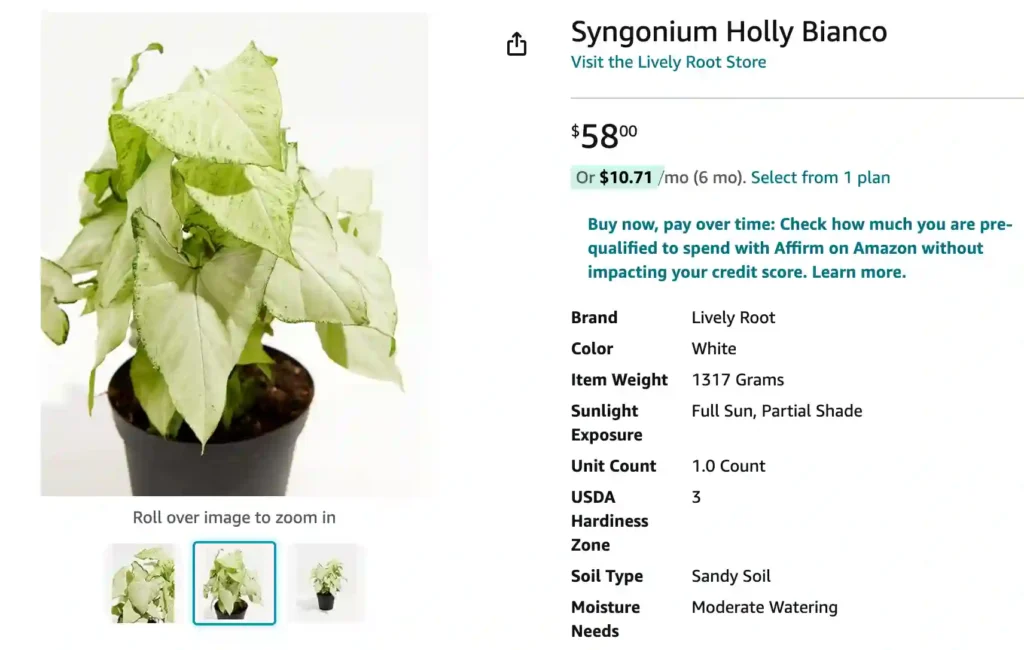
Syngonium Holly: Your Guide to the Stunning Silver Arrowhead Plant
Hi, Ferb Vu here! Today, we’re diving into the world of the Syngonium Holly, a captivating houseplant known for its silvery, arrow-shaped leaves. This tropical beauty is a conversation starter and a breeze to care for, making it ideal for plant enthusiasts of all levels.
Whether you’re a seasoned plant collector or a curious newbie, this FAQ will answer all your burning questions about the Syngonium Holly.
What is a Syngonium Holly?
The Syngonium Holly, a variety of the Syngonium podophyllum, is a climbing vine native to the rainforests of Central and South America. Nicknamed the “Silver Arrowhead” for its distinctive foliage, it boasts stunning silvery-white leaves with a green margin.
As the plant matures, the leaves transform, becoming deeply lobed and resembling an arrowhead or even a hand with five fingers. This unique characteristic adds to the Syngonium Holly’s charm.
What are the Benefits of Owning a Syngonium Holly?
There are many reasons to bring a Syngonium Holly into your home:
- Air Purification: Like many houseplants, the Syngonium Holly helps remove toxins and pollutants from the air, promoting a healthier indoor environment.
- Low Maintenance: This easy-going plant thrives with minimal care, making it perfect for busy schedules.
- Adaptability: The Syngonium Holly tolerates a range of light conditions, from bright indirect light to lower-light environments.
- Aesthetics: The captivating foliage adds a touch of elegance and sophistication to any space.
- Symbolism: In Feng Shui, the five-lobed leaves represent the five elements, fostering harmony and balance.
Syngonium Holly vs. Neon Pothos:
Both the Syngonium Holly and the Neon Pothos are popular houseplants with vibrant foliage. Here’s a quick comparison to help you decide which might be the better fit:
- Leaf Color: Syngonium Holly boasts silvery-white leaves with green edges, while the Neon Pothos features bright chartreuse or lime green foliage.
- Light Requirements: The Syngonium Holly tolerates lower light conditions, while the Neon Pothos prefers brighter indirect light.
- Growth Habit: The Syngonium Holly is a climber, whereas the Neon Pothos is a trailing vine.
Syngonium Holly vs. Silver Queen Pothos:
Another contender is the Silver Queen Pothos, known for its heart-shaped, silver-variegated leaves. Here’s a breakdown:
- Leaf Shape: The Syngonium Holly has arrowhead-shaped leaves, while the Silver Queen Pothos has heart-shaped leaves.
- Leaf Coloration: The Syngonium Holly has a more prominent silver color compared to the Silver Queen Pothos’ variegation.
- Growth Pattern: The Syngonium Holly is a climber, while the Silver Queen Pothos is a trailing vine.
Syngonium Holly vs White Butterfly
Compared to the Syngoniums White Butterfly variety, Syngoniums Holly stands out due to its prominently white center and minimal green areas. On the other hand, White Butterfly maintains a more substantial presence of green. Beyond its unique visual traits, Holly is also celebrated for its easy-to-manage care requirements. Syngoniums naturally possess a climbing inclination and benefit from the use of climbing aids for support.
How to Care for Your Syngonium Holly?
Here’s what you need to know to keep your Syngonium Holly thriving:
- Light: Bright indirect light is ideal. Avoid direct sunlight, which can scorch the leaves.
- Watering: Water deeply when the top inch of soil dries out. Overwatering is a common enemy, so ensure proper drainage.
- Soil: A well-draining potting mix is essential. Consider a mix formulated for aroids like Monsteras.
- Humidity: While not strictly necessary, moderate humidity levels will benefit your Syngonium Holly.
- Fertilizer: During the growing season (spring and summer), a balanced fertilizer diluted to half strength can be applied monthly.
How to Propagate Your Syngonium Holly?
Propagating your Syngonium Holly is a rewarding experience. Here’s a simple method:
- Take a stem cutting with at least two nodes.
- Remove the lower leaves and dip the cut end in rooting hormone (optional).
- Place the cutting in a pot filled with moist, well-draining potting mix.
- Cover the pot with a plastic bag to create a humid environment.
- Ensure indirect light and keep the soil consistently moist.
- Roots should develop within a few weeks. Once established, gradually remove the plastic bag and treat the new plant like a mature Syngonium Holly.
Conclusion
The Syngonium Holly is a stunning and easy-to-care-for houseplant that adds a touch of elegance and vibrancy to any space. With its air-purifying properties, beautiful foliage, and adaptability, it’s a perfect choice for plant enthusiasts of all levels is sure to become a cherished member of your indoor jungle.




